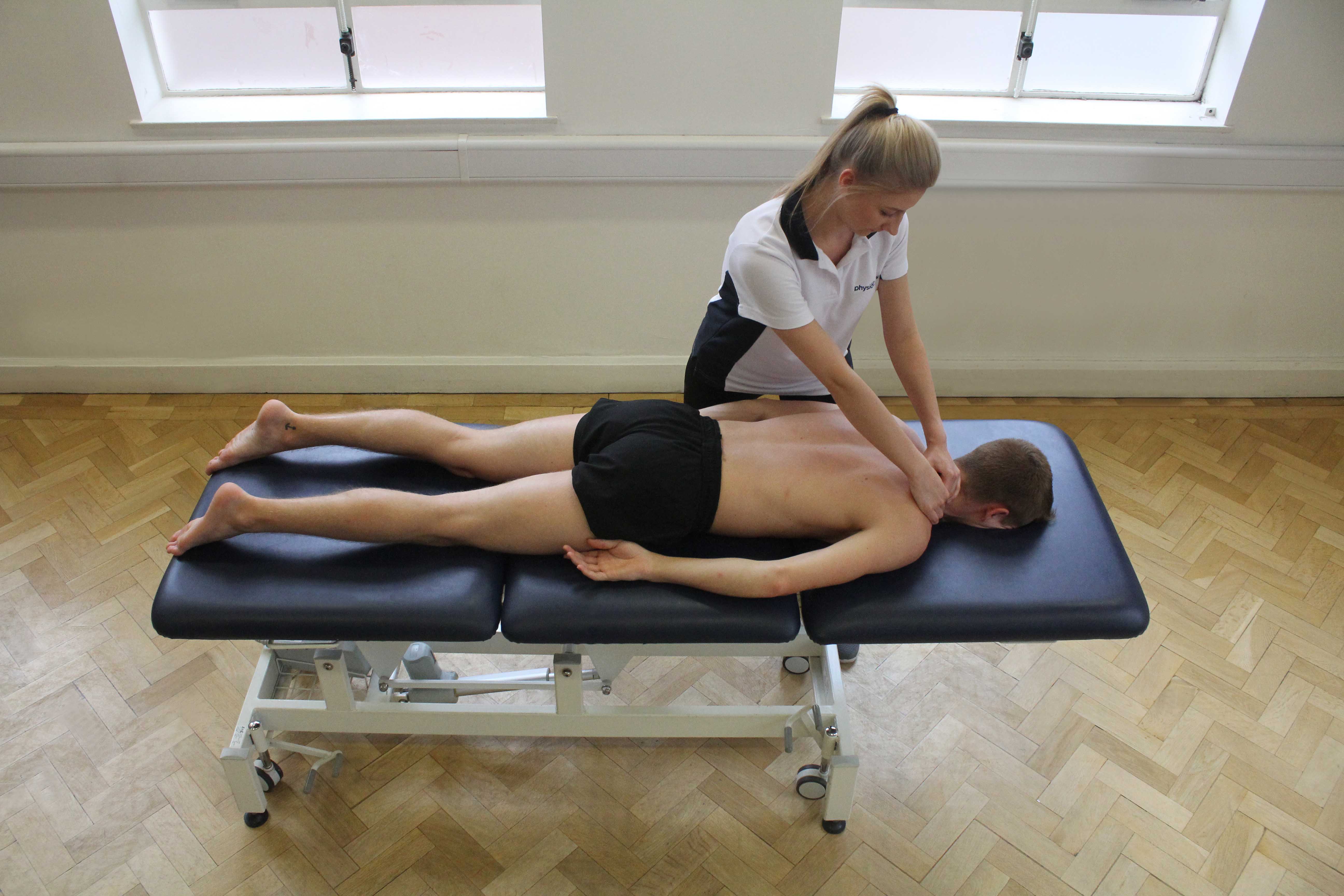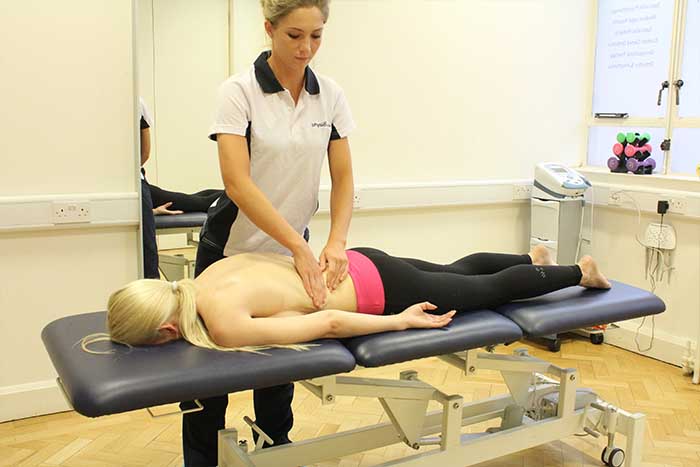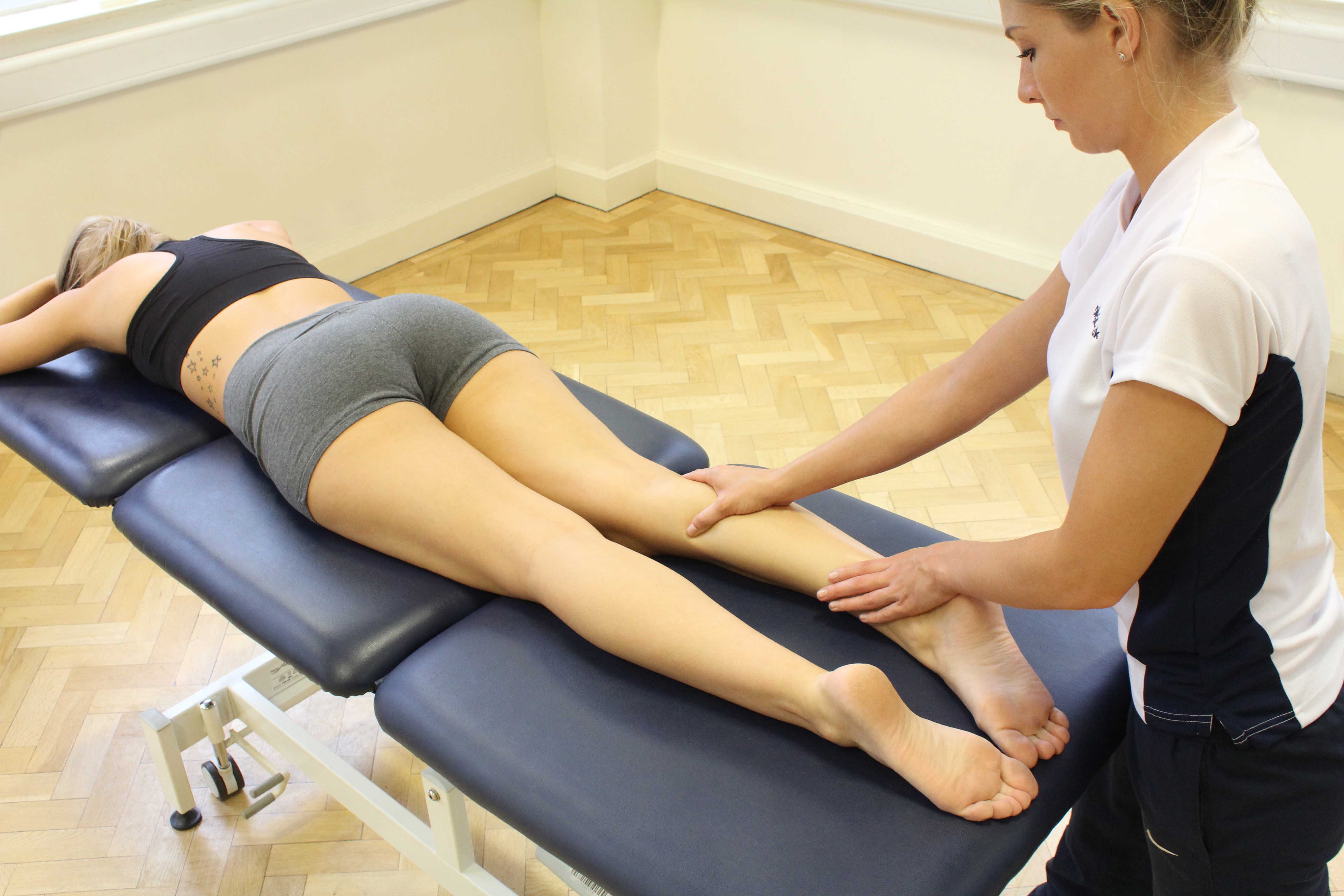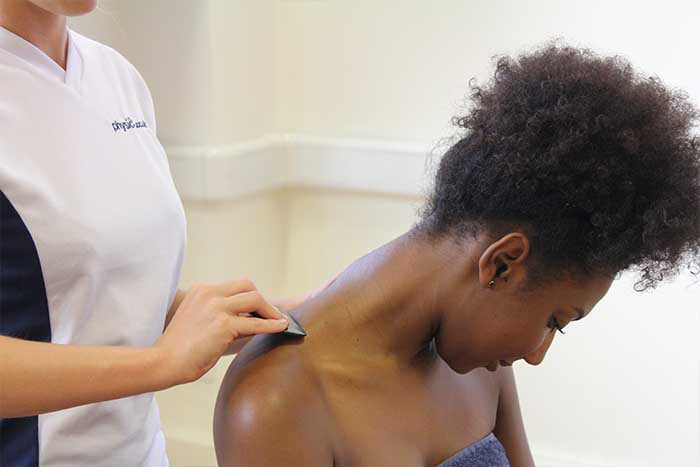Prevention of delayed onset muscle soreness is a common benefit gained through massage. Delayed onset muscle is where microscopic tears occur within muscles most often caused by overuse and poor cool down after exercise. When a muscle is overused and cool down is not completed, the build-up of waste products that occurs during exercise is not removed from the body. When left unremoved, a build-up of wastes products causes muscular ache, fatigue and weakness also known as delayed onset muscle soreness. A massage aims to remove the waste products from the muscle before they can have a negative effect. Our massage therapists at Physio.co.uk prevent delayed onset muscle soreness through massage to help increase healing and improve performance.
What are the most appropriate types of massage to prevent delayed onset muscle soreness?
There are many massage types suitable for the prevention of delayed onset muscle soreness. The most common types of massage used include:
 Above: Soft Tissue Massage targeting trapezius muscle
Above: Soft Tissue Massage targeting trapezius muscleThe massage types most often used to prevent delayed onset muscle soreness include deep tissue massage, sports massage and remedial massage.
A deep tissue massage is often used to prevent delayed onset muscle soreness. A range of pressures and techniques are used within a deep tissue massage with the aim to get into the deeper layers of muscle fibres and tissues. A deep tissue massage helps to prevent delayed onset muscle soreness by encouraging an increase in blood and lymph flow. An increase in blood flow provides the worked muscles with oxygen for an increase in energy and nutrients for the repair of damaged fibres. An increase in lymph flow flushes out wastes products contributing to muscular ache and fatigue more quickly. A deep tissue massage also encourages relaxation of tight, tense muscles further preventing delayed onset muscle soreness.
Delayed onset muscle soreness can be prevented through sports massage. A sports massage uses a wide range of pressures throughout, which depend on personal preference or the muscle condition. A sports massage can often be an intense style massage aiming to improve muscle condition and increase healing. Muscle condition and healing is increased by the encouragement of an increase in blood flow. Essential oxygen and nutrients are carried within the blood flow and are used for the repair of damaged muscles and to provide the muscle with an increase in energy. An increase in energy prevents muscular fatigue and ache, therefore preventing delayed onset muscle soreness.
A remedial massage can be used for the prevention of delayed onset muscle soreness. A remedial massage can be used for both relaxation and to improve muscle condition. Using remedial massage for relaxation can prevent delayed onset muscle soreness as tight, tense, overused muscles are encouraged to relax and loosen to prevent pain and muscular ache. Improving muscle condition through remedial massage increases the repair of broken muscle fibres that have occurred due to overworked muscle from intense exercise or activity. Repairing broken muscle fibres more quickly prevents pain from increasing and muscles from tension, which both help to prevent delayed onset muscle soreness.

What techniques are used to prevent delayed onset muscle soreness?
A wide range of techniques can be used to prevent delayed onset muscle soreness. The techniques most commonly used include:
 Above: Soft Tissue Massage targeting gastrocnemius and soleus muscles
Above: Soft Tissue Massage targeting gastrocnemius and soleus musclesThe most common techniques used in the prevention of delayed onset muscle soreness include deep strokes, kneading and trigger pointing.
Deep strokes are used to prevent delayed onset muscle soreness. Deep strokes are where flattened hands and fingers are used to place a firm pressure on to the treatment area. Long directional strokes are used within deep strokes with ranges of pressure depending on the muscle condition. Deep strokes enable the therapist to get deep within muscle fibres in order to encourage relaxation and increase healing through an increase in blood flow. Bundles of collagen fibres called adhesions are also broken down through deep strokes. Adhesions form after overuse or injury and contribute towards delayed onset muscle soreness. Improving muscle relaxation, increasing healing and breaking down adhesions all help to prevent delayed onset muscle soreness.
Kneading is regularly used to prevent delayed onset muscle soreness. Kneading is where picking up and squeezing actions are used on soft tissues in order to loosen muscles and increase circulation. Lymphatic circulation is increased through kneading. Metabolic wastes and toxins are carried within the lymphatic system and removed from the body. Increasing lymphatic circulation encourages a rise in metabolic wastes to be removed from the body, preventing them from causing muscle fatigue and weakness. Muscle fatigue and weakness increases pain and the chances of injury, therefore increasing delayed onset muscle soreness. Prevention of muscle fatigue and weakness helps to prevent delayed onset muscle soreness.
Prevention of delayed onset muscle soreness occurs through trigger pointing. A trigger point can be found in the centre of a muscle fibre. Trigger points are formed by a build-up of muscular tension and can cause an increase in pain, restriction in movement and increased stress levels. After intense exercise or activity, tension builds up within muscles due to being over use. The build-up of tension can often lead to trigger points which contribute to delayed onset muscle soreness. Trigger pointing involves applying pressure to the trigger point using fingertips or thumbs. Applying pressure helps to soften and break down the trigger point to help relieve the build-up of tension. Relief of tension causing trigger points reduces the chance of pain and restricted movement and therefore prevents delayed onset muscle soreness.
When can a massage help to prevent delayed onset muscle soreness?
Preventing delayed onset muscle soreness can help in a range of situations. The most common situations prevention of delayed onset muscle soreness can help include:
Preventing delayed onset muscle soreness can help as part of a training programme, post event and improve relaxation.
Prevention of delayed onset muscle soreness can help as part of a training programme. Delayed onset muscle soreness causes muscle to fatigue and weaken, making them more likely to tire and injure during training. If muscles tire more easily within a training programme, the person will not be able to reach their full potential and targets may not get reached. An increase in the chances of injury can prevent a person from taking part in the training programme altogether. By preventing delayed onset muscle soreness, muscles are less likely to fatigue and injure, allowing a person to reach their full potential during training with no limitations.
Delayed onset muscle soreness prevention can help post event. After an event, metabolic wastes such as lactic acid build-up within muscles. Metabolic wastes cause pain to increase and can prevent microscopic tears on muscle fibres from healing, increasing the chance of injury when a person returns to training. Prevention of delayed onset muscle soreness after an event would involve the removal of waste products through stimulation of the lymphatic system. Removing waste products to prevent delayed onset muscle soreness, avoids pain and chances of injury to enable a person to return to training more quickly.
Relaxation is increased if delayed onset muscle soreness is prevented. After exercise, muscles already tend to feel slightly sore, tired and weak. If delayed onset muscle soreness is not prevented, the sore, tired and weak feelings will increase causing relaxation to decrease and stress to increase. Preventing delayed onset muscle soreness allows muscle to return to full health and range of movement more quickly without feelings of pain, fatigue or weakness. Reducing the chances of pain, fatigue and weakness within muscles by preventing delayed onset muscle soreness decreases the chances of stress levels rising and increases relaxation.

What are the physiological effects of massage to prevent delayed onset muscle soreness?
A variety of physiological effects occur during a massage to help prevent delayed onset muscle soreness. The most common physiological effects that occur include:
The physiological effects that most commonly occur to help prevent delayed onset muscle soreness include the removal of waste products, increased oxygenation and increased tissue elasticity.
The removal of waste products occurs during a massage to help prevent delayed onset muscle soreness. Intense exercise or training causes a build-up of waste products to occur within the worked muscles. Waste products contribute to muscular fatigue, ache and weakness which are all main parts of delayed onset muscle soreness. A massage stimulates the lymphatic system. The lymphatic system is made up of tiny lymph vessels and is responsible for the removal of waste products. Stimulation of the lymphatic system encourages the removal of waste products to increase. Increasing the removal of waste products prevents delayed onset muscle soreness from occurring, as the waste products are removed before they can have a negative effect.
A massage increases oxygenation in order to prevent delayed onset muscle soreness. Increased oxygenation involves an increase in blood flow carrying oxygen being transported to all muscles. A part of delayed onset muscle soreness is caused by muscular fatigue and weakness. Increasing oxygenation to the fatigue muscles provides them with an increase in energy. An increase in energy reduces fatigue. As well as being used as an energy source, increased oxygenation also contributes to healthier and stronger muscles, therefore reducing weakened muscles. A reduction of fatigued and weakened muscles prevents delayed onset muscle soreness from occurring.
Increased tissue elasticity can help prevent delayed onset muscle soreness. Intense training or activity can cause muscles to tighten. Tight muscles cause an increase in pain which contributes to delayed onset muscle soreness. Muscles often become tight due to a lack of tissue elasticity. When tissue elasticity is good, muscles are able to reach full length on a stretch without a feeling of pain or tightness. Tissue elasticity increases by an increase in temperature. An increase in temperature occurs due to the friction created between the skin and fingers, which encourages blood flow to increase. As temperature of tissues increase, inelasticity reduces. Reducing the inelasticity of tissues increases their ability to stretch to its full length, decreasing muscle tightness. A decrease in muscle tightness through increase tissue elasticity avoids pain from increasing and delayed onset muscle soreness from occurring.
Summary
Delayed onset muscle soreness is the microscopic tears of muscle fibres and the build-up of waste products within muscles. Various massage types can be used to prevent delayed onset muscle soreness including deep tissue massage, sports massage and remedial massage. Techniques including deep strokes, kneading and trigger pointing are regularly used to prevent delayed onset muscle soreness. Preventing delayed onset muscle soreness can help a person as part of a training programme, post event and improve relaxation. A range of physiological effects occur during a massage in order to prevent delayed onset muscle soreness, the most common including the removal of waste products, increased oxygenation and increased tissue elasticity. Our massage therapists at Physio.co.uk prevent delayed onset muscle soreness through massage to help relieve muscle tension and improve muscle condition.
How can I arrange a massage to prevent delayed onset muscle soreness?
The easiest way to arrange a massage to prevent delayed onset muscle soreness at Physio.co.uk is to email us at office@physio.co.uk or call us on 0800 033 7800.
You can also book an appointment online and save £10

 0330 088 7800
0330 088 7800


































